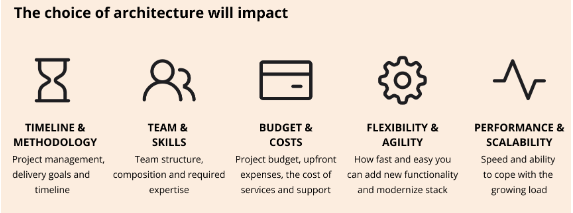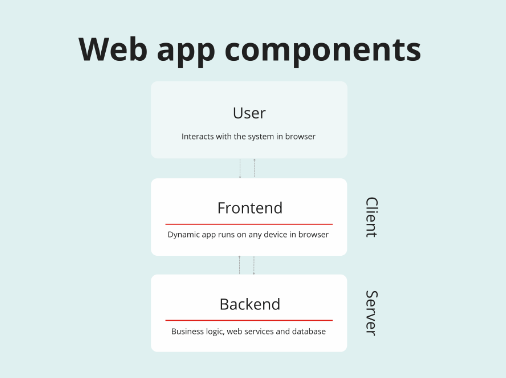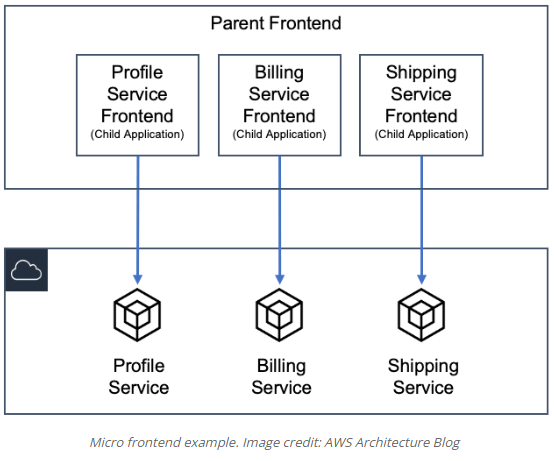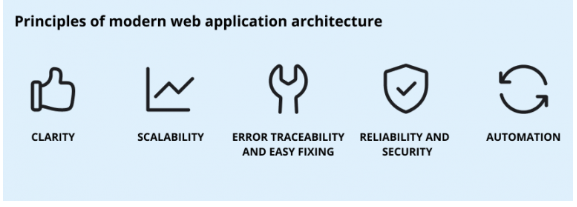
Your Modern Web Architecture Must Future-Proof Your Product – Find Out How
Table of Contents
- What is Modern Web Architecture?
- Why is it so Important?
- Diagramtical Explanation of Web application architecture
- Types of modern web app architecture for various projects
- Best Practices of Web application architecture
- Develop a future-ready custom web app with Softqube
While working on a project how do you choose a suitable web application architecture? Do you really check with the required parameters or do wide research or just select it randomly?
Finding the right architectural style for your application will always give you the upper hand. Looking at the scalability requirements, the structure of your organization and the project goals and volume will impact the decision. Making mistakes at this fundamental step can cost you a lot and will affect you in the long run.
Worry not. If you know different types of architecture and their features, functionalities, and the reasons why they exist, it will help you select a future-proof approach for your awesome project and avoid further costs.
Let us head over to all that we are going to discuss in this post.
What is Modern Web Architecture & Why is it So Important?
Software architecture means the main components, structure, and layout of the system. It also defines how system parts connect and communicate with each other. Talking about the architecture of a modern web application, let us find out what relations exist between the high-level structural parts.
- Client application: user interacts here with the browser
- Web server: process requests and provides responses
- Databases: storing and accessing data
- Cloud services: for all types of cloud-native solutions
- Third-party APIs and integrations and much more
To know the reasons for choosing modern web architecture for your application, there are some key factors and properties of your application you know and how it impacts directly choice

Methodology and Timeline
The amount of time it will take to create your application, the way your team will handle the requirements, and organize and manage project development.
Team and skills
Web development team structure, required expertise, and composition
Cost
Budget of the entire project, cost of services of web development, upfront expenses, and technologies that you will require to get it up and running
Flexibility
The speed of adopting new services or technologies, modernization, and migration to new platforms or frameworks, adding new features and functionality
Performance
Finding the overall pace and ability to handle the growing load and an increasing amount of user requests, data, etc. with zero compromises on user experiences
Support
Need of skills and cost for supporting the application and maintaining infrastructure
So as you can see, the choice of architecture creates an impact on how the application will work and when you will put your product into the market-leading what amount costs. All this goes beyond the technical requirements. And all these choices will directly impact your business objectives and goals.
In addition, the architectural approach is going to play a fundamental role in the ability of your application to scale and evolve with the changing goals and technical requirements. In the post, we are going to talk in detail about the characteristics of web applications and give quick tips on how to choose the right type of web application architecture.
Diagramtical Explanation of Web application architecture
Take this classic example of a modern web architecture for your application that consists of two basic components that are a client-side application – that runs in a browser and a server-side – code at the backend. These components are the core parts of any web application and they can transform into different forms based on various architectural styles.

Client-Side
The client-side application is also known as frontend and refers to the dynamic web interface opened by users in a browser to interact with real-time situations. Like sending requests, surfing pages and scrolling, using online services and much more. The responsive, quick, and rich front end is developed with modern Javascript libraries and frameworks like React, Angular, Vue.js, etc.
Server-Side
The role of server-side components is to receive, process and respond to the request coming from the client application. In the simple diagram above you will see the backend generally has all the business logic and performs the heavy lifting. Also, it validates user requests, stores the database, pulls out data from the database, and is quickly responsive to the requests.
With a gamut of programming languages, tools and frameworks in the tech stack, you can develop the choicest web application at the backend. Your choice is based on various factors that include the type of web application and its functionality.
Looking from the very beginning, you will find this architecture diagram above very simple for developing web apps giving you a general overview of what all contained in a web app.
Based on the specification of each app, the task distribution varies between the front end and the back end. In some cases, some parts are moved to the client-side for attaining a certain speed and usability goals. While in other cases, the core components of the web application architecture transform into a pretty complex multi-component structure addressing important technical requirements or business goals.
Types of modern web app architecture for various projects
Various modern approaches can be applied to build a web application. Apps like Gmail, Uber, Slack, or NetFlix use some of these seven widely used modern web architectures. We shall split based on the two components.
Server-side Approach
Microservices
One of the most eminent and widely applicable approaches to building scalable web applications. Microservices is based on the principle of modularity and decentralization. To be precise, the system is bifurcated into a range of microservices. And each microservice is created around a single business function and then deployed on an independent basis. It can also be created with a customized set of technologies having its data flow and database.
This approach is well known for being highly scalable and reliable with incredible tech and business agility. Being so popular, it builds large and distributed web applications with great ease and flexibility.
Monolith
One of the most simple approaches to creating a web app architecture. The monolithic web application is built as a single unit that operates most of the functions. At its core, it has many layers such as business logic, presentation, and data. All user requests are directed to these layers and returned back to the user with a response. Monoliths comprise one or more databases and can be hosted on in-house servers, in the cloud, and also can be integrated with third-party platforms.
One of the most important characteristics of monolith is its undivided future. Monolith is often faster to perform the entire app development cycle which makes it a viable and cost-effective solution for MVPs and small projects needing to be rolled out with a stricter deadline. Along with the same, monolith applications take time to scale and get modernized due to their requirement of making changes to the entire system.
Serverless
Serverless means deploying applications and running them on outside servers that are owned and maintained by cloud service providers. There are various modern cloud platforms such as AWS, Google Cloud and MS Azure containing an entire set of tools and services for managing, building, and supporting a web application infrastructure of any kind of complexity and volume.
Serverless architecture is a great option for companies who do not have the in-house expertise to take care of their web app infrastructure or reduce the cost of support by providing flexible pricing that is given by the cloud providers.
Single-page applications
A single-page application exactly performs what the name suggests. It offers the years only one web page that keeps changing whenever the user clicks on something or does interact with the page. The page is not reloaded entirely while the user sends the request. Instead, SPA makes relevant updates on the relevant component of the page. And that is why SPA apps are lightweight, quick and highly responsive. Works great for apps like Google Maps etc.
Multi-page applications
It is a traditional design approach tailored for applications with multiple workflows and functions. MPA is implemented by way of several dynamic web pages. Each of the page functions distinctively and gets reloaded whenever a user sends a new request. Like eCommerce web application that contains separate pages for various services.
Progressive Web applications (PWA)
In the past years, PWA has offered a lot of acceptability because of its two major benefits. One is its offline mode functionality and providing improved user experience. PWAs merge the idea of a web app that runs in a browser with a native application that is installed on the device. This becomes real when PWAs start taking advantage of the service worker who sits in browsers, processes the request of the users and pulls the data according to the requirement.
Micro Frontend

You can make a healthy comparison between microservices and the micro frontend approach. Here, the client-side of the web application structure is split into different independent modules that can be developed and deployed by using various technologies as per the server functions. The advantage of the component is its flexibility and scalability. You can develop and deploy every micro front end on its own. In addition, you can split your development teams to work in parallel and increase speed to focus on specific business functions. Micro frontend gives a good solution if combined with microservices.
Best Practices of Web application architecture

Some modern web architecture for the apps are developed with the best practices and principles that can help you understand which approach works best.
Clarity
However complex your web app structure is, you must keep it understandable, simple, and navigable with clean and reusable codes.
Scalability
The entire web app and each component must be scalable as per the given requirements and future business needs
Security and reliability
The security standards must take care of the security needs because web app architecture is meant to be built with great reliability and consistency
Error traceability and effective fixing
The technical team must find it easy to detect, trace and fix the errors with no major failures
Automation
In case possible, app testing, deployment, maintenance and support should be automated to improve productivity and reduce costs.
Develop a future-ready custom web app with Softqube
Working on a new app or want a skilled team of developers and experts who can implement your project at the right time? Are you finding ways to optimize and scale your current product and migrate to microservices and leverage the cloud?
If this is all you are looking for and anything similar around, Softqube is here to assist you. From a team of senior engineers, designers, architects, and developers with project managers, we have a proven track of successful deliveries. You can rely on our specialists no matter what stage of the project you are in. Contact our experts and tell us about your project today.


